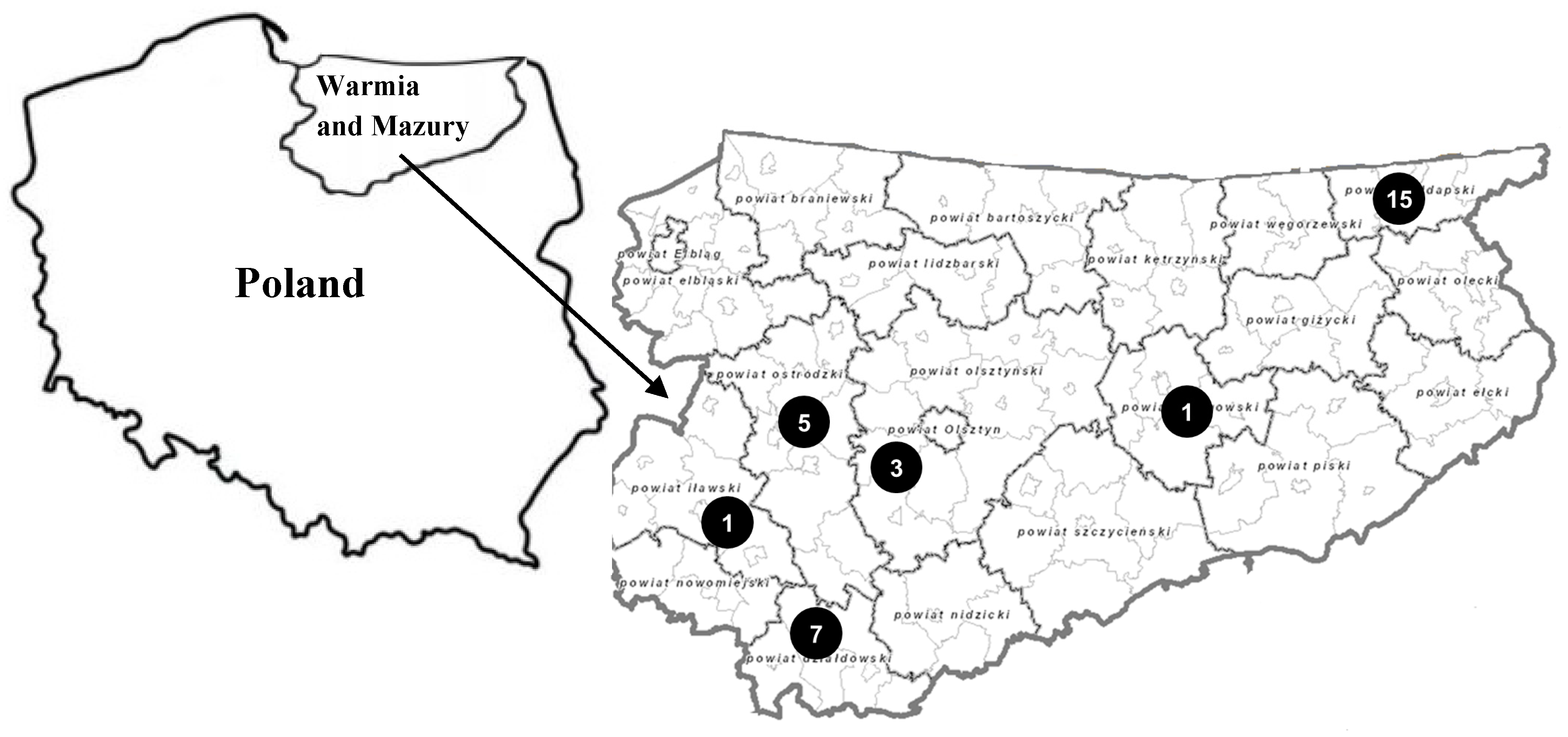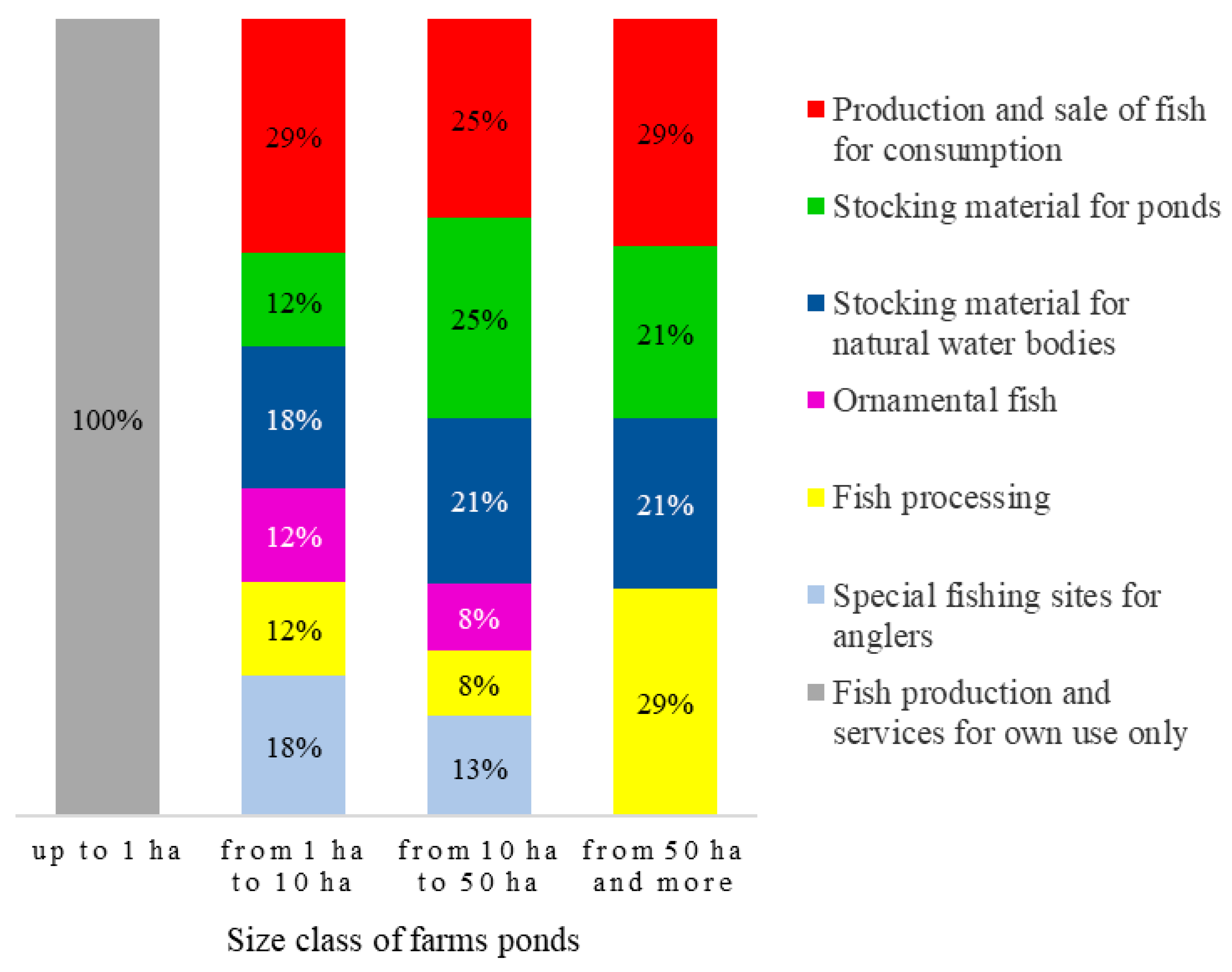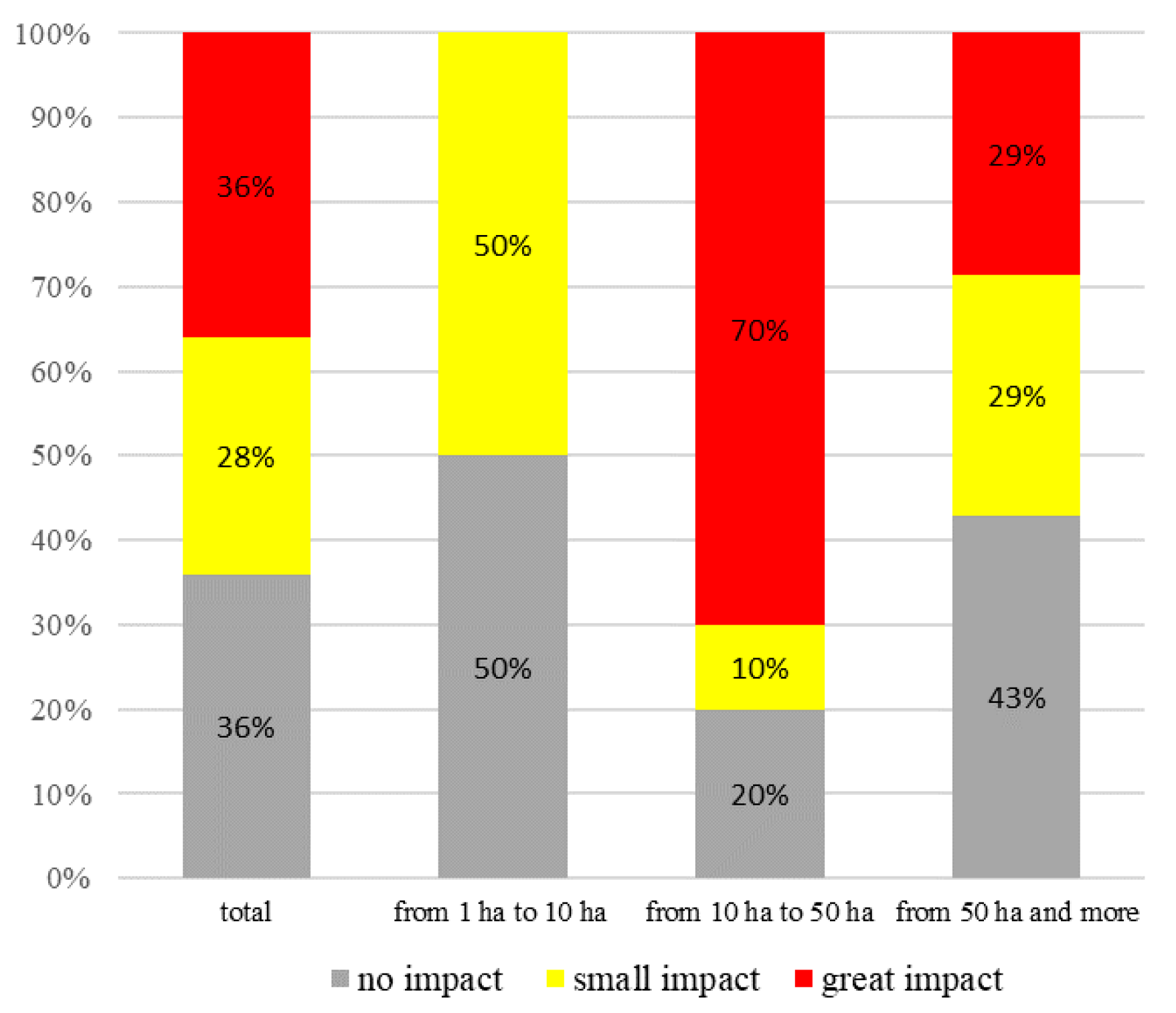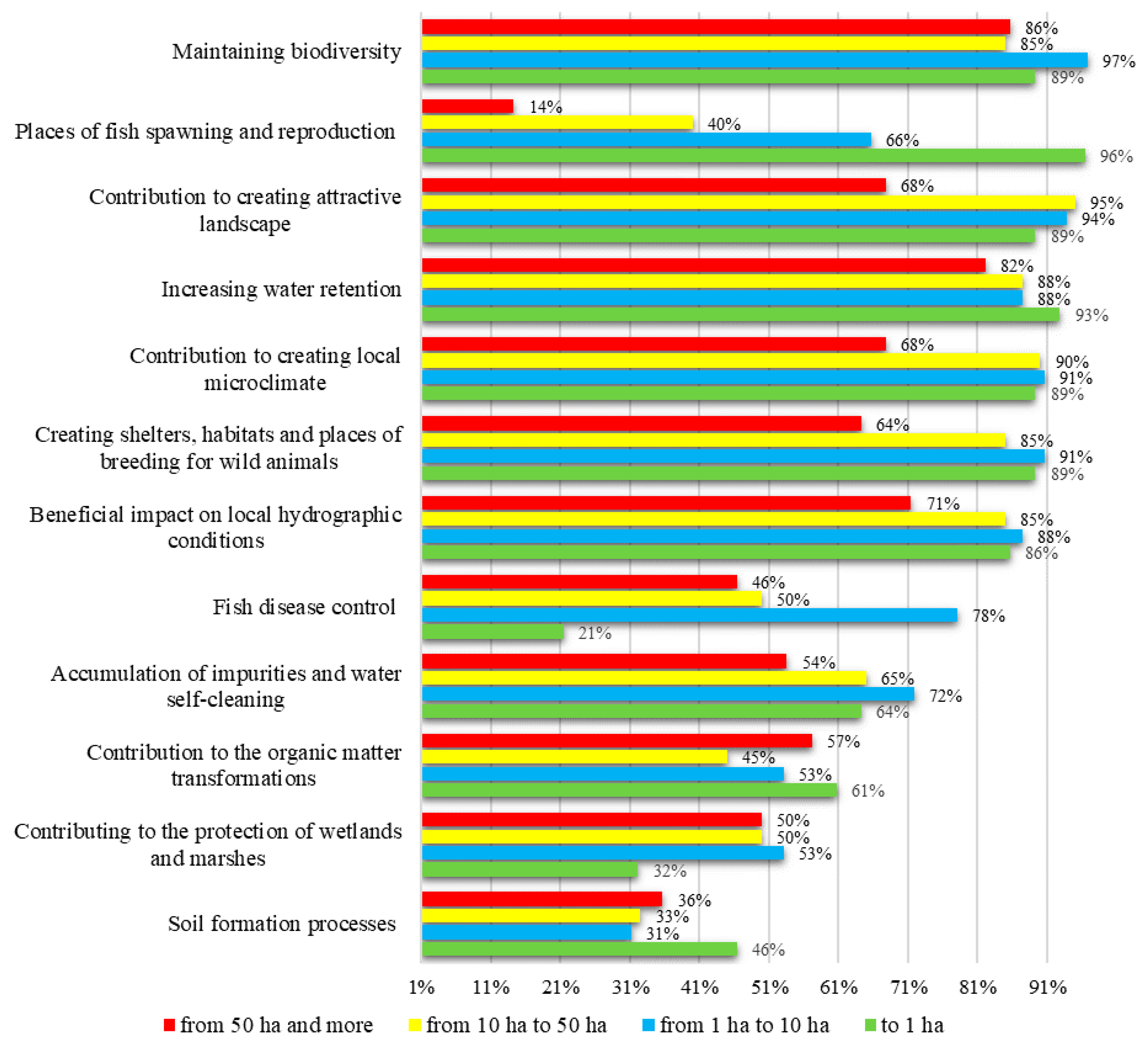Fish Farmers’ Perception of Ecosystem Services and Diversification of Carp Pond Aquaculture: A Case Study from Warmia and Mazury, Poland
Abstract
:1. Introduction
2. Materials and Methods
2.1. Study Area
2.2. Data Collection and Analysis
3. Results and Discussion
3.1. What Kind of Commercial Activity Is Carried Out on the Ponds?
3.2. How Does Additional Activity Affect the Financial Condition of Pond Farms?
3.3. Farmers Evaluation of Carp Ponds Ecosystem Services/Multifunctionality
3.4. European Compensation Instrument for the Costs and/or Income Foregone in Aquaculture Providing Environmental Services
- Aquaculture methods compatible with specific environmental needs and subject to specific management requirements resulting from the designation of Natura 2000 areas.
- Participation, in terms of directly related costs, in ex-situ conservation and reproduction of aquatic animals, within the framework of conservation and biodiversity restoration programs developed by public authorities, or under their supervision.
- Aquaculture operations which include conservation and improvement of the environment and biodiversity and management of the landscape and traditional features of aquaculture zones.
4. Conclusions
Funding
Institutional Review Board Statement
Informed Consent Statement
Data Availability Statement
Conflicts of Interest
Appendix A
| Total registered area of ponds (ha) | |
| Average annual yield (kg) (for the last three years) | |
| Main fish markets (local, regional, domestic) and forms of sale |
| No. | Service/Function of Carp Ponds | 0 | 1 | 2 | 3 | 4 |
|---|---|---|---|---|---|---|
| 1 | accumulation of impurities and water self-cleaning | |||||
| 2 | beneficial impact on local hydrographic conditions | |||||
| 3 | contributing to the protection of wetlands and marshes | |||||
| 4 | contribution to creating attractive landscape | |||||
| 5 | contribution to creating local microclimate | |||||
| 6 | contribution to the organic matter transformations | |||||
| 7 | creating shelters, habitats, and places of breeding for wild animals | |||||
| 8 | energy production | |||||
| 9 | fiber production | |||||
| 10 | fish disease control | |||||
| 11 | increasing water retention | |||||
| 12 | maintaining biodiversity | |||||
| 13 | medical resources for potential future use (e.g., medicinal plants) | |||||
| 14 | ornamental plants cultivation | |||||
| 15 | places for tourism | |||||
| 16 | places of fish spawning and reproduction | |||||
| 17 | places of hunting and angling | |||||
| 18 | places of leisure and recreation | |||||
| 19 | plankton production | |||||
| 20 | plants production | |||||
| 21 | pond as a fire reservoir | |||||
| 22 | ponds as cultural resources | |||||
| 23 | production of fertilizers for agriculture | |||||
| 24 | production of fish and other aquatic organisms | |||||
| 25 | protection against storms and floods | |||||
| 26 | raising environmental awareness | |||||
| 27 | soil formation processes | |||||
| 28 | source of inspiration | |||||
| 29 | sources of “know-how” |
| What Kind of Commercial Activity Is Carried Out on the Ponds? | |
| production and sale of fish for consumption | ☐ |
| stocking material for ponds | ☐ |
| stocking material for natural water bodies | ☐ |
| ornamental fish | ☐ |
| fish processing | ☐ |
| special fishing sites for anglers | ☐ |
| fish production and services for own use only | ☐ |
| What Additional Activities Are Carried Out on the Ponds? | |
| schools’ trips | ☐ |
| educational paths | ☐ |
| birdwatching sites | ☐ |
| fish frying point | ☐ |
| agri- and eco-tourism | ☐ |
| water sport equipment rental | ☐ |
| conference organization | ☐ |
| fishing museum | ☐ |
| others: | |
| Is It Possible to Integrate Use of Carp Ponds with Other Forms of Farming? If so, Indicate Examples: | |
| irrigation of agricultural crops | ☐ |
| managing waste from intensive fish fattening (carp, African catfish, etc.) | ☐ |
| aquaponics (greenhouse cultivation of plants using water from fishponds) | ☐ |
| cultivation of cranberries | ☐ |
| growing energy crops | ☐ |
| others: | |
| What Additional Activities Can Be Undertaken on Your Ponds? | |
| schools’ trips | ☐ |
| educational paths | ☐ |
| birdwatching sites | ☐ |
| fish frying point | ☐ |
| agri- and eco-tourism | ☐ |
| water sport equipment rental | ☐ |
| conference organization | ☐ |
| fishing museum | ☐ |
| others: | |
| How Do These Additional Activities Affect the Financial Condition of Your Farm? | |
| great impact | ☐ |
| small impact | ☐ |
| no impact | ☐ |
| 1. How Do You Evaluate the Current System of Aqua-Environmental Measures? | |||||
| ☐ bad | ☐ mediocre | ☐ sufficient | ☐ good | ☐ very good | |
| 2. Please Give Reasons for Negative Assessment of the System? | |||||
| is too expanded | ☐ | ||||
| is too complicated | ☐ | ||||
| over-expanded system of documenting the task performance verification | ☐ | ||||
| others: | |||||
| 3. Is It Worth Maintaining the System of Aqua-Environmental Measures? | |||||
| ☐ yes | ☐ no | ||||
| 4. Should Compensation for Interruptions in Fish Production Be Introduced? If so, It Is Because of: | |||||
| fish diseases | ☐ | ||||
| flooding | ☐ | ||||
| drought | ☐ | ||||
| water pollution | ☐ | ||||
| others: | |||||
| This kind of compensation should not be introduced. | ☐ | ||||
References
- FAO Yearbook. Fishery and Aquaculture Statistics 2018; FAO: Rome, Italy, 2020; pp. 23–36. ISBN 978-92-5-133371-6. [Google Scholar]
- Science for Environment Policy. Sustainable Aquaculture. Future Brief. 11; UWE: Bristol, UK, 2015; ISBN 978-92-79-43993-3. [Google Scholar]
- 2020 Blue Economy Report: Blue Sectors Contribute to the Recovery and Pave Way for EU Green Deal. Available online: https://ec.europa.eu/commission/presscorner/detail/en/ip_20_986 (accessed on 29 January 2021).
- Aubin, J.; Callier, M.; Rey-Valette, H.; Mathe, S.; Wilfart, A.; Legendre, M.; Slembrouck, J.; Caruso, D.; Chia, E.; Masson, G.; et al. Implementing ecological intensification in fish farming: Definition and principles from contrasting experiences. Rev. Aquac. 2019, 11, 149–167. [Google Scholar] [CrossRef] [Green Version]
- Soto, D.; Aguilar-Manjarrez, J.; Hishamunda, N. (Eds.) Building an Ecosystem Approach to Aquaculture; FAO: Rome, Italy, 2008; ISBN 978-92-5-106075-9. [Google Scholar]
- Aquaculture Development. 4. Ecosystem Approach to Aquaculture; FAO Technical Guidelines for Responsible Fisheries. No. 5, Suppl. 4; FAO: Rome, Italy, 2010; ISBN 978-92-5-106650-8.
- Pokorný, J.; Hauser, V. The restoration of fish ponds in agricultural landscapes. Ecol. Eng. 2002, 18, 555–574. [Google Scholar] [CrossRef]
- Mathé, S.; Rey-Valette, H. Local knowledge of pond fish-farming ecosystem services: Management implications of Stakeholders’ perceptions in three different contexts (Brazil, France and Indonesia). Sustainability 2015, 7, 7644–7666. [Google Scholar] [CrossRef] [Green Version]
- Lasner, T.; Mytlewski, A.; Nourry, M.; Rakowski, M.; Oberle, M. Carp land: Economics of fish farms and the impact of region-marketing in the Aischgrund (DEU) and Barycz Valley (POL). Aquaculture 2020, 519, 734731. [Google Scholar] [CrossRef]
- Adámek, Z.; Mössmer, M.; Hauber, M. Current principles and issues affecting organic carp (Cyprinus carpio) pond farming. Aquaculture 2019, 512, 734261. [Google Scholar] [CrossRef]
- Adámek, Z.; Linhart, O.; Kratochvíl, M.; Flajšhans, M.; Randák, T.; Policar, T.; Masojídek, J.; Kozák, P. Aquaculture the Czech Republic in 2012: Modern European prosperous sector based on thousand-year history of pond culture. Aquac. Eur. 2012, 37, 5–14. [Google Scholar]
- Leopold, M. Poland. In World Fish Farming: Cultivation and Economics, 2nd ed.; Brown, E.E., Ed.; Avi Publishing Company, Inc.: Westport, CT, USA, 1983; pp. 231–256. ISBN 978-1-4684-6872-4. [Google Scholar]
- Dobrowolski, K.A. (Ed.) Environmental-Economic Evaluation of Fish Ponds in Poland; The World Conservation Union (Fundacja IUCN Poland): Warsaw, Poland, 1995; ISBN 2-8317-0281-X. [Google Scholar]
- Ĉižkova, H.; Květ, J.; Comín, A.; Laiho, R.; Pokorný, J.; Pithart, D. Actual state of European wetlands and their possible future in the context of global climate change. Aquat. Sci. 2013, 75, 3–26. [Google Scholar] [CrossRef] [Green Version]
- Varadi, L.; Bardócz, T.; Oberdieck, A. SustainAqua—Integrated Approach for a Sustainable and Healthy Freshwater Aquaculture. SustainAqua Handbook—A Handbook for Sustainable Aquaculture. Available online: https://haki.naik.hu/sites/default/files/uploads/2018-09/sustainaqua_handbook_en.pdf (accessed on 2 December 2019).
- Uzunova, E.; Radeva, E.; Tzonev, R. Inland aquaculture development in the NATURA 2000 sites in Bulgaria: Ecological approach and aqua-environmental measures. Bulg. J. Agric. Sci. 2015, 21, 56–60. [Google Scholar]
- Lukácsik, M.B.; Domán, C.; Hamza, E.; Rácz, K.; Szabó, D.; Vásáry, V.; György, Á.I. Producer perceptions of fish pond management on Natura 2000 sites in Hungary. European Aquaculture Society, Edinburgh, Scotland Meeting Abstract, 1–3. 2016. Available online: https://www.was.org/easonline/AbstractDetail.aspx?i=6555 (accessed on 1 December 2019).
- Gómez-Baggethun, E.; de Groot, R.; Lomas, P.L.; Montes, C. The history of ecosystem services in economic theory and practice: From early notions to markets and payment schemes. Ecol. Econ. 2010, 69, 1209–1218. [Google Scholar] [CrossRef]
- Costanza, R.; d’Arge, R.; de Groot, R.; Farber, S.; Grasso, M.; Hannon, B.; Limburg, K.; Naeem, S.; O’Neill, R.V.; Paruelo, J.; et al. The value of the world’s ecosystem services and natural capital. Nature 1997, 387, 253–260. [Google Scholar] [CrossRef]
- Millennium Ecosystem Assessment. Ecosystems and Human Well-Being: Synthesis; Island Press: Washington, DC, USA, 2005; ISBN 1-59726-040-1.
- Haines-Young, R.; Potschin, M. Common International Classification of Ecosystem Services (CICES): Consultation on Version 4. August–December 2012. EEA Framework Contract No EEA/IEA/09/003. Available online: www.nottingham.ac.uk/cem (accessed on 29 January 2021).
- Nyman, J.A. Ecological functions of wetlands. In Wetlands. Integrating Multidisciplinary Concept; LePage, B.A., Ed.; Springer: New York, NY, USA, 2011; pp. 115–129. ISBN 978-94-007-0550-0. [Google Scholar]
- Turkowski, K.; Lirski, A. Non-productive function of fish ponds and their possible economic evaluation. In Carp Culture in Europe: Current Status, Problems, Perspectives; Lirski, A., Pyć, A., Eds.; IRŚ Press: Olsztyn, Poland, 2011; pp. 25–42. ISBN 978-83-60111-57-4. [Google Scholar]
- Békefi, E.; Váradi, L. Multifunctional pond fish farms in Hungary. Aquacult. Int. 2007, 15, 227–233. [Google Scholar] [CrossRef]
- Popp, J.; Békefi, E.; Duleba, S.; Oláh, J. Multifunctionality of pond fish farms in the opinion of the farm managers: The case of Hungary. Rev. Aquac. 2018, 1–18. [Google Scholar] [CrossRef] [Green Version]
- Glossary of Statistical Terms. Organisation for Economic Co-Operation and Development. Available online: https://stats.oecd.org/glossary/ (accessed on 20 January 2021).
- Huang, J.; Tichit, M.; Poulot, M.; Darly, S.; Li, S.; Petit, C.; Aubry, C. Comparative review of multifunctionality and ecosystem services in sustainable agriculture. J. Environ. Manag. 2015, 149, 138–147. [Google Scholar] [CrossRef]
- Pullin, R.S.V. Diversification in aquaculture: Species, farmed types and culture systems. In Planning for Aquaculture Diversification: The Importance of Climate Change and Other Drivers; Harvey, B., Soto, D., Carolsfeld, J., Beveridge, M., Bartley, D.M., Eds.; Fisheries and Aquaculture Proceedings No. 47; FAO: Rome, Italy, 2017; pp. 15–36. ISBN 978-92-5-109788-5. [Google Scholar]
- Budzich-Tabor, U.; Rigaud, A.; da Silva, S.G.; van de Walle, G. Integrating Aquaculture within Local Communities; European Commission, Directorate-General for Maritime Affairs and Fisheries, Director-General: Brussels, Belgium, 2018; ISBN 978-92-79-65198-4. [Google Scholar]
- Raftowicz, M.; Le Gallic, B. Inland aquaculture of carps in Poland: Between tradition and innovation. Aquaculture 2020, 518, 1–8. [Google Scholar] [CrossRef]
- Wietzman, J. Applying the ecosystem services concept to aquaculture: A review of approaches, definitions, and uses. Ecosyst. Serv. 2019, 35, 194–206. [Google Scholar] [CrossRef]
- Willot, P.A.; Aubin, J.; Salles, J.M.; Wilfart, A. Ecosystem service framework and typology for an ecosystem approach to aquaculture. Aquaculture 2019, 512, 734260. [Google Scholar] [CrossRef]
- Regulation (EU) no 508/2014 of the European Parliament and of the Council of on the European Maritime and Fisheries Fund and Repealing Council Regulations (EC) No 2328/2003, (EC) No 861/2006, (EC) No 1198/2006 and (EC) No 791/2007 and Regulation (EU) No 1255/2011 of the European Parliament and of the Council. 2014.
- Turkowski, K. Towards sustainable aquaculture in Poland. In Proceedings of the 2018 International Scientific Conference “Economic Sciences for Agribusiness and Rural Economy” No 1, Warsaw, Poland, 7–8 June 2018; ISBN 978-83-7583-802-2. [Google Scholar] [CrossRef] [Green Version]
- Turkowski, K.; Lirski, A. The economics of carp farms in Poland. Acta Ichthyol. Piscat. 2010, 40, 137–144. [Google Scholar] [CrossRef]
- Blandford, A. Semi-structured qualitative studies. In The Encyclopedia of Human-Computer Interaction, 2nd ed.; Soegaard, M., Dam, R.F., Eds.; The Interaction Design Foundation: Aarhus, Denmark, 2013; Available online: http://www.interactiondesign.org/encyclopedia/semi-structured_qualitative_studies.html (accessed on 3 August 2020).
- Diei-Ouadi, Y.; Mgawe, Y.I. Post-Harvest Fish Loss Assessment in Small-Scale Fisheries: A Guide for the Extension Officer; FAO: Rome, Italy, 2011; pp. 13–19. ISBN 978-92-5-106880-9. [Google Scholar]







| Size Class of Farm Ponds | Up to 1 ha | From 1 to 10 ha | From 10 to 50 ha | From 50 ha and More |
|---|---|---|---|---|
| Number of farms | 7 | 6 | 7 | 4 |
| Number of respondents | 7 | 8 | 10 | 7 |
| Total registered area of ponds (ha) | 3.10 | 29.40 | 180.70 | 542.00 |
| Average farms’ ponds area (ha) | 0.44 | 4.90 | 25.81 | 135.50 |
| Share of respondents with secondary or higher education in fisheries | 0% | 28% | 33% | 100% |
| Organizational form of the farm: | ||||
| individual (family) agriculture farm | 7 | 4 | 3 | - |
| individual (family) aquaculture farm | - | 2 | 3 | - |
| limited liability aquaculture and lake fisheries company | - | - | 1 | 4 |
| Average yield (kg of fish per 1 ha) | 258 | 550 | 1010 | 729 |
| Main markets and forms of sale of fish | for own needs (not for sale) | fishing grounds for anglers, local, domestic, and foreign market | ||
| Specification | From 1 to 10 ha | From 10 to 50 ha | From 50 ha and More | |||
|---|---|---|---|---|---|---|
| Implemented | Planned | Implemented | Planned | Implemented | Planned | |
| Schools’ trips | 14% | - | 17% | 17% | - | - |
| Educational paths | 14% | 29% | 50% | 17% | 25% | - |
| Birdwatching sites | - | 14% | 50% | 17% | 25% | - |
| Fish frying point | - | 14% | 33% | 17% | 25% | - |
| Agri- and eco-tourism | - | - | 33% | 33% | 25% | - |
| Water sport equipment rental | - | - | - | 17% | - | - |
| Conference Organization | - | - | - | 33% | - | - |
| Fishing museum | - | - | - | 33% | - | - |
| Specification | From 1 to 10 ha | From 10 to 50 ha | From 50 ha and More | Total |
|---|---|---|---|---|
| Irrigation of agricultural crops | 13% | 20% | - | 12% |
| Managing waste from intensive fish fattening (carp, African catfish, etc.) | 13% | 50% | - | 24% |
| Aquaponics (greenhouse cultivation of plants using water from fishponds) | 13% | 30% | - | 16% |
| Cultivation of cranberries | 13% | 30% | - | 16% |
| Growing energy crops | - | - | - | - |
Publisher’s Note: MDPI stays neutral with regard to jurisdictional claims in published maps and institutional affiliations. |
© 2021 by the author. Licensee MDPI, Basel, Switzerland. This article is an open access article distributed under the terms and conditions of the Creative Commons Attribution (CC BY) license (http://creativecommons.org/licenses/by/4.0/).
Share and Cite
Turkowski, K. Fish Farmers’ Perception of Ecosystem Services and Diversification of Carp Pond Aquaculture: A Case Study from Warmia and Mazury, Poland. Sustainability 2021, 13, 2797. https://doi.org/10.3390/su13052797
Turkowski K. Fish Farmers’ Perception of Ecosystem Services and Diversification of Carp Pond Aquaculture: A Case Study from Warmia and Mazury, Poland. Sustainability. 2021; 13(5):2797. https://doi.org/10.3390/su13052797
Chicago/Turabian StyleTurkowski, Konrad. 2021. "Fish Farmers’ Perception of Ecosystem Services and Diversification of Carp Pond Aquaculture: A Case Study from Warmia and Mazury, Poland" Sustainability 13, no. 5: 2797. https://doi.org/10.3390/su13052797
APA StyleTurkowski, K. (2021). Fish Farmers’ Perception of Ecosystem Services and Diversification of Carp Pond Aquaculture: A Case Study from Warmia and Mazury, Poland. Sustainability, 13(5), 2797. https://doi.org/10.3390/su13052797






